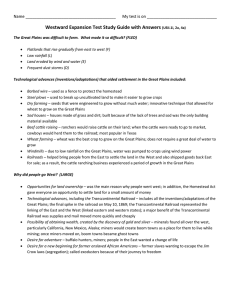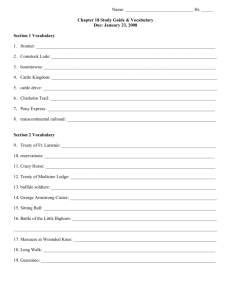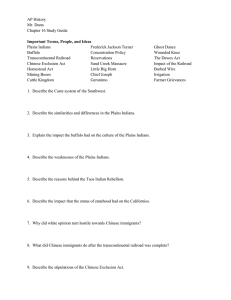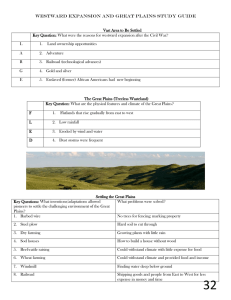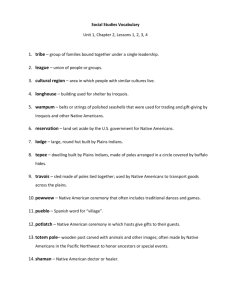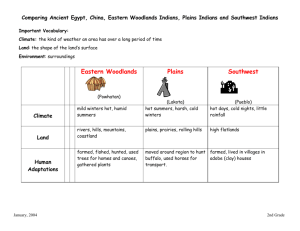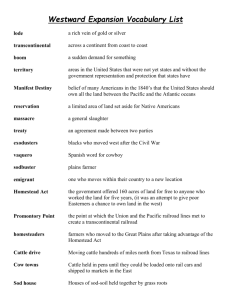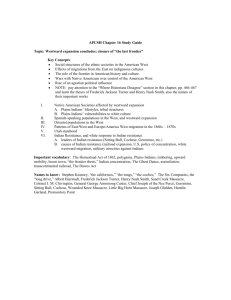Westward Expansion Test Study Guide No Answers Name ________________________________________
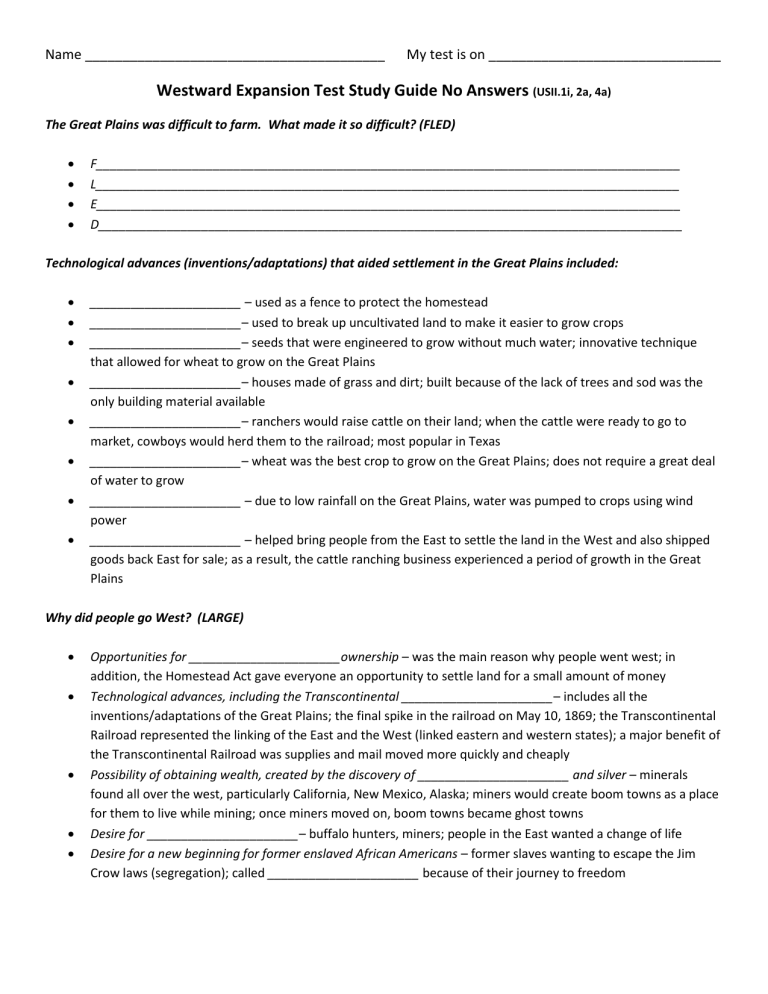
Name ________________________________________ My test is on _______________________________
Westward Expansion Test Study Guide No Answers
(USII.1i, 2a, 4a)
The Great Plains was difficult to farm. What made it so difficult? (FLED)
F_____________________________________________________________________________________
L_____________________________________________________________________________________
E_____________________________________________________________________________________
D_____________________________________________________________________________________
Technological advances (inventions/adaptations) that aided settlement in the Great Plains included:
______________________ – used as a fence to protect the homestead
______________________– used to break up uncultivated land to make it easier to grow crops
______________________– seeds that were engineered to grow without much water; innovative technique that allowed for wheat to grow on the Great Plains
______________________– houses made of grass and dirt; built because of the lack of trees and sod was the only building material available
______________________– ranchers would raise cattle on their land; when the cattle were ready to go to market, cowboys would herd them to the railroad; most popular in Texas
______________________– wheat was the best crop to grow on the Great Plains; does not require a great deal of water to grow
______________________ – due to low rainfall on the Great Plains, water was pumped to crops using wind power
______________________ – helped bring people from the East to settle the land in the West and also shipped goods back East for sale; as a result, the cattle ranching business experienced a period of growth in the Great
Plains
Why did people go West? (LARGE)
Opportunities for ______________________ownership – was the main reason why people went west; in addition, the Homestead Act gave everyone an opportunity to settle land for a small amount of money
Technological advances, including the Transcontinental ______________________– includes all the inventions/adaptations of the Great Plains; the final spike in the railroad on May 10, 1869; the Transcontinental
Railroad represented the linking of the East and the West (linked eastern and western states); a major benefit of the Transcontinental Railroad was supplies and mail moved more quickly and cheaply
Possibility of obtaining wealth, created by the discovery of ______________________ and silver – minerals found all over the west, particularly California, New Mexico, Alaska; miners would create boom towns as a place for them to live while mining; once miners moved on, boom towns became ghost towns
Desire for ______________________– buffalo hunters, miners; people in the East wanted a change of life
Desire for a new beginning for former enslaved African Americans – former slaves wanting to escape the Jim
Crow laws (segregation); called ______________________ because of their journey to freedom
Impact of westward expansion on American Indians (did not benefit from westward expansion) included:
Opposition by American Indians to westward expansion o Battle of ______________________– battle fought in the Black Hills of South Dakota; government wanted to protect land where miners were searching for gold; Lt. Colonel George Custer led his soldiers against the Lakota tribe, led by chief Sitting Bull; Custer underestimated the number of Lakota Indians present at Little Bighorn Valley; Lt. Colonel Custer and all his men died; huge victory for the American
Indians o ______________________ – prominent leader of the Apache Indians in Arizona, New Mexico and Texas; fought in the Apache Wars, in which he tried to stop the US government from taking over Apache land; eventually surrendered to the US
Forced relocation from traditional lands to ______________________– US government wanted to free up more land for settlers to farm; reservations (land where the US government forced American Indians to move and assimilate) o ______________________, Nez Percé tribe – famous quote: located in Pacific Northwest; Chief Joseph did not want to lead his people to a reservation so he tried to move to Canada; eventually surrendered and said the famous quote: “I am tired of fighting…From where the sun now stands, I will fight no more.”
Reduced population through warfare and ______________________ o Battle of ______________________– took place in South Dakota; attack on the Sioux Indians; disheartened the American Indians in their fight to save their native land
______________________ attempts and lifestyle changes – assimilation (adapting or changing to the settlers’ way of life); reduction of ______________________ population by the railroad
Reduced their homelands through______________________ that were broken – government agencies, in a quest for land ownership, broke promises and treaties made with the American Indians
The famous painting, American Progress by John Gast, reflects the ideas and experiences of different groups on the
Great Plains.
Essay: When painting this picture, the painter was attempting to communicate many ideas about westward expansion. Explain the impact of each of the following on the settling of the west: farmers (including inventions), railroads (including the Transcontinental Railroad) and American Indians.

